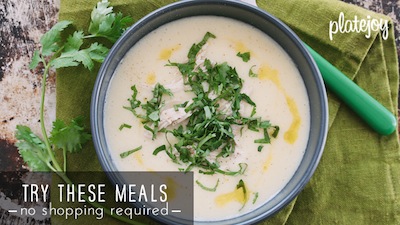Creamy, warm, melt-in-your mouth delicious. I’m not talking about a chocolate fountain (although that sounds pretty good, even at 9am). I’m talking risotto, a traditional Italian rice dish that requires patience and love as you gradually coax the little rices to release their magical starch and create the illustrious, infamous texture that is good enough for the cooking gods.
Now if you are anything like me, you probably think/thought/still think that risotto should be left to the professionals. And I’ll agree that yes, indeed, the professionals can make a mean bowl of delicately textured risotto while yours/mine/everyone else’s ends up more like savory rice pudding – just as tasty, but a perhaps a little heavier.
But I believe that risotto is one of those dishes that you make according to your own likes and dislikes. Like pasta, the more you make it, the more you will come to realize the “doneness” you personally desire – some like the rice to be more on the melty (ie mushy) side while others wish it to be al dente, with a little more bite. Some like the risotto to be filled with cream and cheese, while others make it heavy with vegetables and the natural juices they release.
Although risotto has its culinary roots and traditional preparations, the mere idea of the dish is a great canvas upon which to play. And as a low sodium cook, it is a wonderful starting place from which to riff and ramble and create something really special.
So all of this talk of risotto naturally comes to one conclusion – I’m currently obsessed with it. First, there were the risotto cakes. Then I had the most unbelievable spring pea risotto at Incanto in Noe Valley (straight off the menu since they did not make it with broth and used mascarpone instead of traditional parmesan, kind of an unbelievable low sodium experience). Then I re-made the fennel risotto cakes for a friend’s bachelorette party. And most recently, I enjoyed a delicious low sodium, organic version of Farm & a Frying Pan’s Lemon Risotto at my blogger dinner. Perhaps this fixation is due to the spring season (quickly becoming summer), a time in which we have access to so many flavorful ingredients and foraged delicacies (it is morel time and I love it). But no matter the reason or the season, risotto is a great dish to try and something that definitely gets better with time.
So here is F & FP’s Lemon Risotto recipe with a few low sodium substitutions. Channel your inner Italian mama (or papa) and chow on. Magiamo!
Ingredients:
- 1 lemon
- 1 tablespoon unsalted butter
- 1 tablespoon olive oil
- 1 small onion, finely diced
- 1 1/2 cups arborio rice
- 5 cups low sodium chicken broth
- 1/4 cup vermouth or 1/2 cup white wine
- 2 pounds fava beans, shelled
- 1/2 cup low sodium mascarpone
- 2 tablespoons parsley, chopped
1. Zest and juice the lemon and set aside.
2. Heat butter and olive oil in a large dutch oven over medium heat. Add onion and saute 7-8 minutes, or until tender. In the meantime, pour chicken broth into a saucepan and bring to a simmer. Add rice to dutch oven and stir infrequently for 3-4 minutes, taking care not to burn the rice. Add vermouth (or white wine) and stir frequently until absorbed, about 5 minutes. Stir in lemon zest.
3. Add 1/2 cup of chicken broth, bring rice to a simmer, and stir infrequently until most of the liquid is absorbed and the rice is thick. Continue to add 1/2 cup of hot chicken broth at a time in the same manner until rice is tender, about 30 minutes. When you have about 1 cup of chicken broth left (or after about 20-25 minutes), stir in fava beans.
4. Once rice is done, stir in lemon juice to taste, cheese, parsley, and season with lots of fresh cracked pepper. Serve immediately!









Yay! Something to do with all of the fava beans I just got in my CSA box. My question: do you have to steam the beans before you add them to the risotto?
That’s a good question. To prepare fava beans, you have to blanch them twice. First, to take of the thin, filmy outer coat. And a second time to soften them for eating. But I think with risotto, you probably can skip the second hot water dip since the favas will cook (and soften) along with the rice! Enjoy.